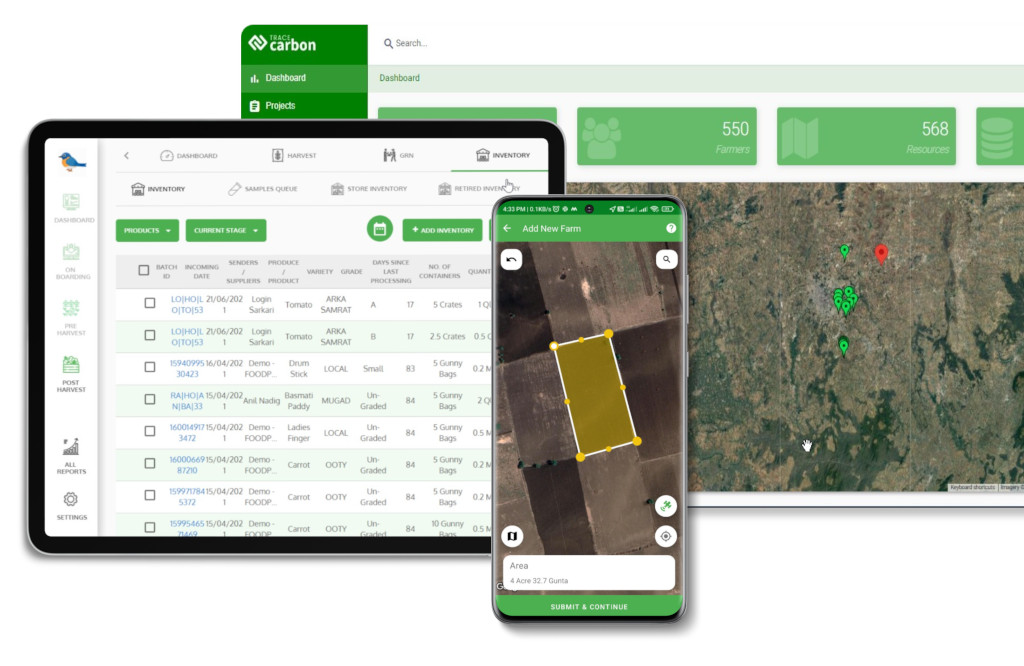Contact: +91 99725 24322 |
Menu
Menu
Quick summary: Learn how producer companies can achieve EUDR compliance through digital onboarding, geolocation mapping, and DDS submission. Step-by-step guidance for regulatory success and market access.

EUDR compliance for producer companies can be enabled by digitally onboarding farmers, capturing farm-level geolocation (point or polygon), verifying post-2020 deforestation-free status, and ensuring legal land use through documented proof. They must compile this data into a Due Diligence Statement (DDS) and submit it via the EU TRACES portal before placing products on the EU market. Compliance also requires ongoing risk assessment and 5-year data retention. According to the European Commission, failure to meet these obligations can result in rejection of shipments or legal penalties
Non-compliance isn’t just a bureaucratic issue—it carries serious consequences, including market bans, shipment detentions, and financial penalties. For producers, especially those working with fragmented, smallholder-based supply chains, meeting EUDR requirements is a high-stakes challenge. To comply, companies must submit a Due Diligence Statement (DDS) through the EU TRACES Portal, which includes verified geolocation data, risk assessments, and documentation proving legal land tenure and deforestation-free status post–31 December 2020.
Navigating this complexity requires digital traceability tools that can map farms, assess deforestation risk, and maintain audit-ready records—especially in regions where smallholder farmers are difficult to digitize without purpose-built field apps. In short, for producers to stay competitive and compliant, embracing end-to-end traceability is no longer optional—it’s a regulatory necessity.
Key Takeaways
Producer companies must first identify if their commodities are in-scope under EUDR using HS codes, determine their legal role (operator or trader), and understand submission deadlines. Operators must prepare and submit a Due Diligence Statement (DDS) via the EU TRACES portal.
EUDR applies to seven key commodities: cattle, cocoa, coffee, oil palm, soy, wood, and rubber—along with many products derived from them. Use Harmonized System (HS) codes to determine if your goods fall within scope. For example, HS 0901 for coffee or 1801 for cocoa beans. Full product lists are available through official EU guidance.
EUDR assigns responsibilities based on your position in the supply chain:
The EUDR entered into force in June 2023, with a compliance deadline of 30 December 2025 for large companies, and 30 June 2026 for SMEs. Each commodity may have additional nuances—such as harvest season, deforestation cutoff date, or traceability depth
The EU’s demand for certain products is linked to deforestation around the world.
Want to understand what products fall under the EUDR?
Read the Blog: Which Commodities Are in Scope Under EUDR?
Unsure about your role as an Operator or Trader?
Explore: EUDR Requirements for Operators vs. Traders—What You Need to Know
These resources break down regulation scope, due diligence obligations, and how your business can stay compliant across the EU supply chain.
To comply with EUDR, producer companies must create a digital registry of all suppliers, including farmer KYC (Know Your Customer) data, land ownership or usage rights, and plot-specific information. This data forms the foundation of traceability and legal verification required for each Due Diligence Statement (DDS).
Because many suppliers are smallholders in remote areas, onboarding should support offline data capture and local languages, enabling field agents to register farmers using mobile apps even without internet. Each farmer ID should be digitally linked to mapped plots and harvest batches to ensure full traceability from farm to shipment.
Recommended tools include:
This step is critical to proving legal sourcing and deforestation-free status as required under the EUDR.
To meet EUDR requirements, producer companies must collect accurate farm-level geolocation data for each plot linked to a commodity. This geodata proves the origin of the product and is critical for verifying deforestation-free status.
To confirm no deforestation occurred after 31 December 2020, companies should run each plot through satellite-based checks:
If only point data is available, apply a buffer radius (e.g. 50–113 meters) to create a pseudo-polygon, allowing satellite and risk layer analysis to still be performed. This is common for smallholders where boundary mapping is limited.
Properly validated geolocation ensures the plot is traceable, legally registered, and demonstrably deforestation-free—core pillars of EUDR compliance.
To comply with the EU Deforestation Regulation (EUDR), producer companies must evaluate each farm plot for both deforestation risk and legal land use. This assessment ensures that all products are sourced from plots that are legally cultivated and free from deforestation since 31 December 2020.
Performing these checks ensures that each plot in your supply chain meets EUDR’s definition of “negligible risk”, and can be confidently included in a compliant Due Diligence Statement (DDS).
Under the EU Deforestation Regulation (EUDR), producer companies are required to compile and maintain detailed documentation and metadata that prove the legality and traceability of each product batch. This documentation forms the backbone of your Due Diligence Statement (DDS) and must be retained for at least five years, as outlined in EUDR Article 11.
1. Core Legal and Land Documents
2. GPS and Geolocation Records
3. Crop Harvest and Transport Records
4. Record Retention Requirements
Maintaining complete, verifiable records ensures not only legal compliance, but also readiness for audits, shipment inspections, and buyer transparency requests under EUDR.
The Due Diligence Statement (DDS) is the core submission required by the EU Deforestation Regulation (EUDR) for all regulated commodities entering the EU market. Producer companies must ensure each DDS is complete, traceable, and correctly formatted before uploading it to the official TRACES portal.
Use a traceability platform to compile:
Ensure your DDS includes:
Submitting a complete and accurate DDS ensures your goods can legally enter the EU market and withstand regulatory checks. Using automated platforms reduces errors and helps meet tight shipment deadlines.
EUDR compliance doesn’t end at DDS submission. Ongoing monitoring, documentation updates, and audit readiness are essential for long-term market access and regulatory assurance. Producer companies must establish robust internal systems to ensure continuous alignment with EUDR requirements.
Use a traceability platform to:
Maintaining audit readiness not only ensures legal compliance but also builds credibility with buyers and positions your company as a trusted, proactive supply chain partner under EUDR.
The TraceX EUDR Compliance Platform is purpose-built to help producer companies—especially those managing fragmented, smallholder-driven supply chains—meet the EU Deforestation Regulation (EUDR) requirements efficiently, accurately, and at scale.
Here’s how TraceX helps at every critical step of EUDR compliance:
Benefit: Ensures every supplier is registered and traceable from day one.
Benefit: Automates one of the most complex aspects of EUDR—accurate and verified mapping.
See Traceability in Action
Discover how digital farm mapping enabled deforestation-free cocoa sourcing in Nigeria.
Read the Full Case Study: Ensuring EUDR-Ready Cocoa Supply Chains
Benefit: Helps ensure all plots meet the “negligible risk” threshold required for DDS.

Benefit: Reduces manual effort and risk of error in regulatory submission.
Benefit: Enables quick responses to EU audits and buyer traceability requests.
For producer companies, implementing EUDR compliance is no longer optional—it’s a strategic necessity. From onboarding farmers and mapping plots to validating deforestation-free status and generating Due Diligence Statements, success depends on adopting digital tools that streamline traceability, risk assessment, and regulatory reporting. A proactive, data-driven approach not only ensures market access in the EU but also builds trust with buyers and future-proofs your supply chain.
Need clarity on due diligence obligations?
Read: EUDR Due Diligence Explained—Steps, Documents & Timelines
Unsure how to assess deforestation and legal risk?
Explore: How to Conduct EUDR-Compliant Risk Assessments
New to EU TRACES?
Guide: Submitting Your EUDR DDS via the EU TRACES Portal
Producer companies must map farm geolocation, verify deforestation-free land post-2020, prove legal land use, and submit a Due Diligence Statement (DDS) via the EU TRACES portal.
Yes, if the plots are in the same country, pertain to the same commodity, and share uniform deforestation and legal risk levels, they can be included in one DDS.
Digital platforms like TraceX automate farmer onboarding, GPS mapping, document collection, risk scoring, and DDS generation—streamlining compliance and reducing human error.
